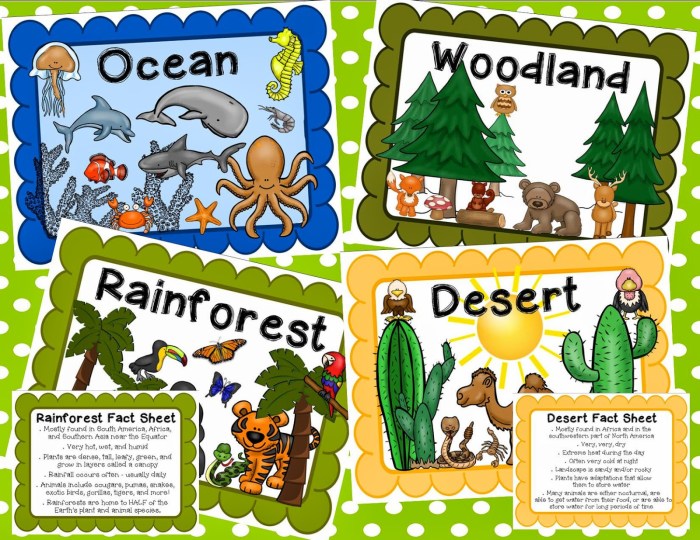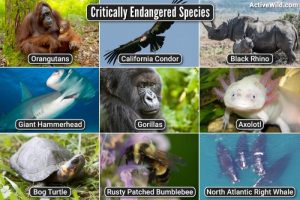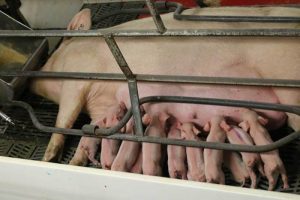
Step into the fascinating world of wild animals and their habitats, where nature’s intricate tapestry unfolds before your eyes. From lush forests to vast savannahs, get ready to embark on a journey filled with wonder and discovery.
As we delve deeper, we’ll uncover the secrets of how different habitats shape the lives of wild creatures, highlighting the delicate balance between survival and human interference.
Habitats of Wild Animals
Wild animals inhabit a variety of habitats around the world, each with unique characteristics that provide essential resources for their survival.
Different Types of Habitats
- Forest: Dense vegetation, ample food sources, and shelter for a wide range of species like tigers, bears, and birds.
- Grassland: Open areas with grasses and few trees, ideal for herbivores like zebras, antelopes, and bison.
- Desert: Harsh environments with limited water and extreme temperatures, home to animals like camels, snakes, and lizards adapted to survive in such conditions.
- Aquatic: Water-based habitats such as oceans, rivers, and lakes supporting diverse species like whales, dolphins, fish, and amphibians.
Importance of Habitats for Wild Animals
Habitats provide wild animals with crucial resources like food, water, shelter, and breeding grounds. The availability of these resources directly impacts their survival and reproductive success.
Human Impact on Wild Animal Habitats
- Deforestation: Clearing of forests for agriculture, logging, and urbanization destroys habitats for countless species, leading to loss of biodiversity.
- Pollution: Contamination of air, water, and soil harms habitats and endangers the health of wildlife through toxic chemicals and waste.
- Urbanization: Expansion of cities and infrastructure encroaches on natural habitats, fragmenting ecosystems and disrupting animal populations.
Endangered Species and Threatened Habitats
- Sumatran Tiger: Habitat loss due to palm oil plantations and illegal logging has pushed this iconic big cat to the brink of extinction.
- Black Rhino: Poaching and habitat destruction have severely reduced the population of black rhinos in Africa, threatening their survival.
- Pangolin: Illegal wildlife trade and habitat destruction have put pangolins at risk, making them one of the most trafficked mammals in the world.
Animals
Animals have remarkable abilities to adapt to their habitats in order to survive and thrive. Whether it’s through physical characteristics, behavior, or feeding habits, animals have evolved unique strategies to ensure their survival in diverse environments.
Adaptations to Habitats
- Camouflage: Many animals have evolved colors and patterns that help them blend into their surroundings, making them less visible to predators or prey.
- Hibernation: Some animals go into a state of deep sleep during harsh winter months to conserve energy and survive when food is scarce.
- Migration: Birds and mammals often travel long distances to find suitable breeding grounds, food sources, or escape unfavorable conditions.
- Specialized Diets: Animals have developed specific feeding habits to utilize the resources available in their habitats, such as herbivores eating plants or carnivores hunting prey.
Importance of Habitat Preservation
Habitats provide essential resources like food, water, shelter, and breeding grounds for a wide variety of animal species. By preserving diverse habitats, we can protect biodiversity, prevent species extinction, and maintain ecological balance in ecosystems.
Ecological Balance
Animals play a crucial role in shaping their habitats through activities like seed dispersal, soil aeration, and predation. By interacting with their environment, animals help maintain a delicate balance that supports the health and stability of ecosystems.
Role of Animals in Habitat Formation
Animals like beavers, termites, and corals actively modify their habitats through building structures, digging burrows, or creating reefs. These alterations can have far-reaching effects on the landscape and influence other species that share the habitat.
Livestock

Livestock refers to domesticated animals raised for various purposes such as food, fiber, and labor. Unlike wild animals, livestock have specific habitat requirements that are often managed by humans to ensure their well-being and productivity.Livestock grazing can have a significant impact on wild animal habitats, especially when overgrazing occurs. This can lead to habitat degradation, soil erosion, and loss of biodiversity, affecting the overall ecosystem balance.
However, sustainable livestock farming practices can coexist with wild habitats by implementing rotational grazing, proper land management, and restoration efforts.
Sustainable Livestock Farming Practices
- Rotational Grazing: Rotating livestock to different pastures allows vegetation to recover, reducing the impact on wild habitats.
- Proper Land Management: Implementing fencing, water sources, and shelter for livestock can help prevent overgrazing in sensitive areas.
- Restoration Efforts: Reintroducing native vegetation, restoring riparian zones, and creating wildlife corridors can enhance habitat quality for both livestock and wild animals.
Role of Livestock in Ecosystems
Livestock play a crucial role in certain ecosystems by contributing to nutrient cycling, vegetation management, and soil health. Grazing livestock can help control invasive plant species, promote grassland diversity, and create habitat heterogeneity that benefits a variety of wildlife species.
Wild Animals

Wild animals have evolved a range of behavioral adaptations to survive in their respective habitats. These adaptations include camouflage, mimicry, hibernation, migration, and specialized feeding behaviors that help them find food and avoid predators.
Behavioral Adaptations
- Camouflage: Many animals have developed colors or patterns that help them blend into their surroundings, making it easier to hunt or hide from predators.
- Mimicry: Some species mimic the appearance of other animals or objects to deceive predators or prey.
- Hibernation: Animals like bears and ground squirrels go into a state of dormancy during extreme cold or food scarcity to conserve energy.
- Migration: Birds, fish, and mammals travel long distances seasonally to find food, breed, or escape harsh weather conditions.
- Specialized Feeding Behaviors: Animals have adapted unique ways to obtain food, such as using tools, hunting in groups, or feeding on specific plants.
Challenges Faced by Wild Animals
- Habitat Loss: Deforestation, urbanization, and agriculture have led to the destruction of natural habitats, forcing animals to adapt or face extinction.
- Habitat Fragmentation: Division of habitats due to roads, dams, and human settlements disrupts animal migration routes and isolates populations, reducing genetic diversity.
Keystone Species and Habitat Diversity
Keystone species are animals that play a crucial role in maintaining ecosystem balance and diversity. Their presence or absence can have a significant impact on the entire habitat.
For example, beavers are considered a keystone species in wetland ecosystems because their dam-building activities create habitats for various other species.
Wildlife Conservation Efforts
- Protected Areas: National parks, wildlife reserves, and marine sanctuaries provide safe havens for wild animals to thrive without human interference.
- Habitat Restoration: Efforts to reforest degraded areas, remove invasive species, and create wildlife corridors help restore habitats for endangered species.
- Community Engagement: Involving local communities in conservation projects promotes sustainable practices and reduces human-wildlife conflicts.
Final Summary
In conclusion, Habitats of wild animals not only showcases the beauty of our natural world but also underscores the urgent need to protect and preserve these vital ecosystems for generations to come. Let’s continue to marvel at the wonders of wildlife and work together to ensure a harmonious coexistence between humans and our animal counterparts.
Popular Questions
How do wild animals adapt to different habitats?
Wild animals adapt to their habitats through physical changes, behavior modifications, and evolutionary processes over time.
What are some examples of endangered species facing habitat threats?
Species like the Bengal tiger, orangutan, and sea turtle are among those whose habitats are increasingly threatened by human activities.
What is the significance of keystone species in maintaining habitat diversity?
Keystone species play a crucial role in their ecosystems, influencing the survival of other species and maintaining the overall balance of the habitat.





